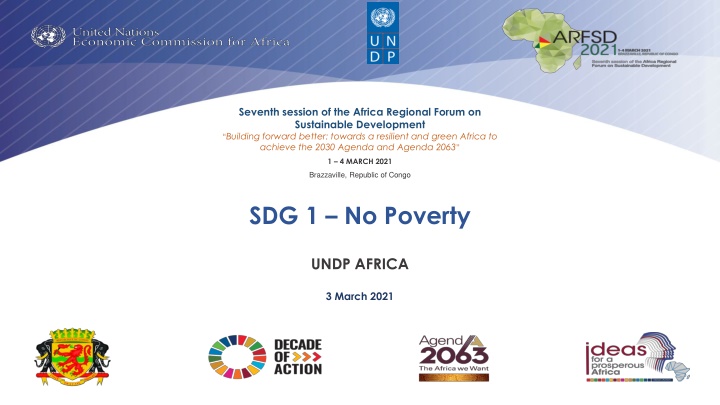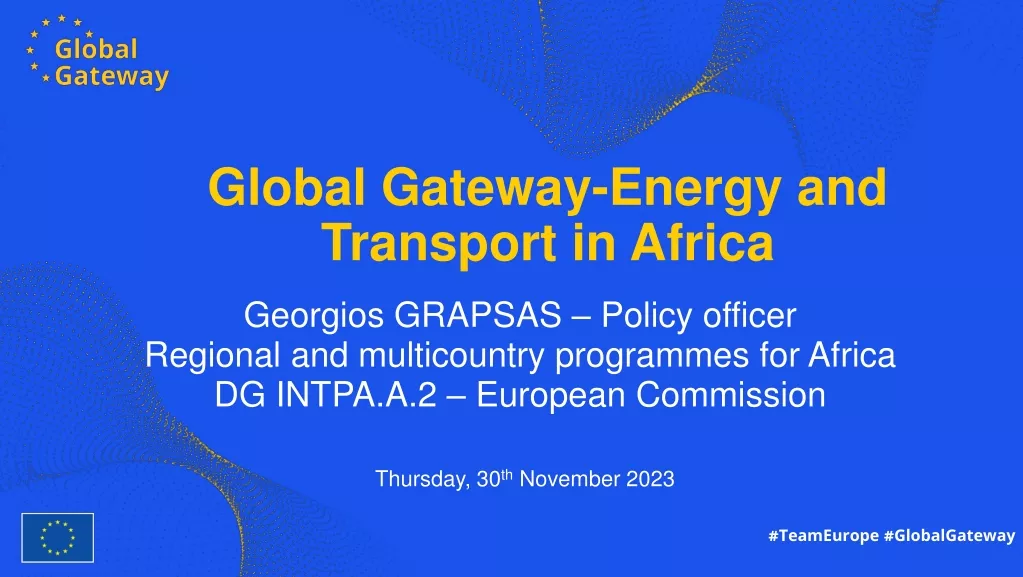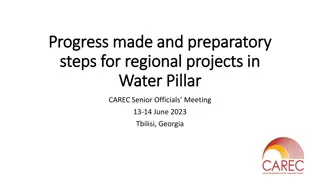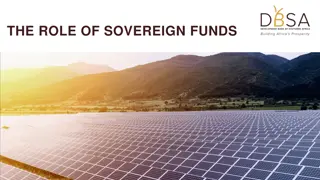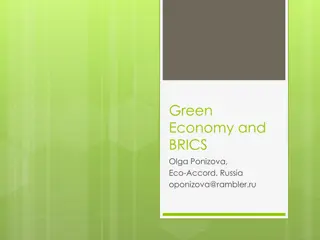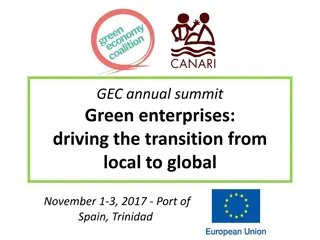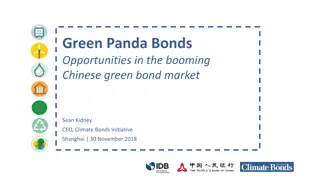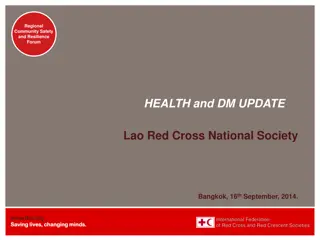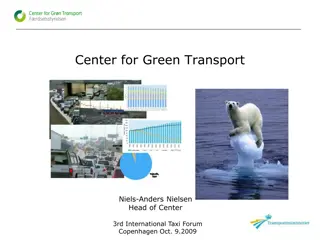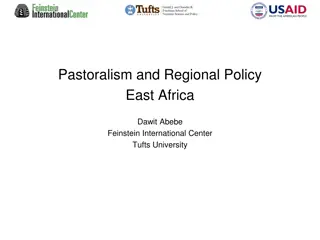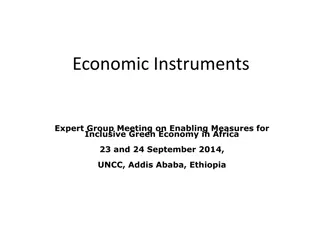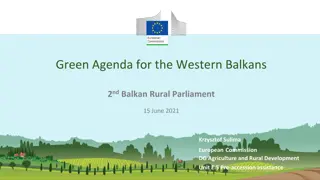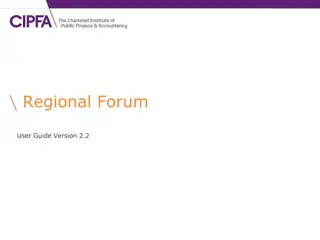Africa Regional Forum on Sustainable Development: Building a Resilient and Green Africa
SDG 1 aims to end poverty globally, but data availability at the country level shows gaps. Economic growth is key to poverty reduction, with mixed trends in Africa. Despite progress, COVID-19 has increased global poverty, emphasizing the need for sustained efforts.
Download Presentation

Please find below an Image/Link to download the presentation.
The content on the website is provided AS IS for your information and personal use only. It may not be sold, licensed, or shared on other websites without obtaining consent from the author.If you encounter any issues during the download, it is possible that the publisher has removed the file from their server.
You are allowed to download the files provided on this website for personal or commercial use, subject to the condition that they are used lawfully. All files are the property of their respective owners.
The content on the website is provided AS IS for your information and personal use only. It may not be sold, licensed, or shared on other websites without obtaining consent from the author.
E N D
Presentation Transcript
Seventh session of the Africa Regional Forum on Sustainable Development Building forward better: towards a resilient and green Africa to achieve the 2030 Agenda and Agenda 2063 1 4 MARCH 2021 Brazzaville, Republic of Congo SDG 1 No Poverty UNDP AFRICA 3 March 2021
Goal 1: No Poverty Context SDG 1 aims to end poverty in all its forms everywhere. Data availability at the country level presents a mixed picture, with considerable gaps in quality, timeliness and the level of The goal has 7 targets and 12 indicators and is aligned with goal 1 of the Agenda 2063. disaggregation. Before COVID 19, the world was off track to end poverty by 2030. And now, COVID 19 has caused the first increase in global poverty in decades, further exacerbating the poverty crisis.
Economic Growth and Poverty Reduction Poverty reduction is possible based on sustained growth and strategic policy interventions over a long period of time. GDP growth (annual %) in Africa compared with other regions, 2010-2019 7 Declining trend in growth in Africa (excl. Middle East & North Africa). Noteworthy are big economies like Nigeria, Angola, and South Africa. Positive trends recorded in Mauritius, Rwanda, Senegal, and Ethiopia andin MENA. 6 5 4 Poverty is declining in Africa, though not significantly. Africa s poverty headcount ratio declined from 41 per cent in 2013 to 36 per cent in 2016 (AUC 2018). 3 2 The share of Africans living in extreme poverty has fallen substantially from 54% in 1990 to 41% in 2015 but the number of poor people increased from 278 million in 1990 to 413 million in 2018 (WB 2019). 1 0 Africa (excl. North Africa) Middle East & North Africa Latin America & Caribbean East Asia & Pacific South Asia World -1 2010 2013 2019 Source: World Bank 2020 The COVID-19 pandemic might have resulted in an estimated 100 million new poor (ECA 2020)
Trends 1.1. Eradicate extreme poverty for all people everywhere Employed population below international poverty line (%) in Africa compared with other regions 60 55.5 50 40.7 40 35.9 30 23.6 19.1 20 15.8 15.3 14.3 11.7 10.3 9.4 9.3 10 7.1 6.7 5 4.6 4.5 4.5 3.5 3.3 2.9 2.7 2.4 2.3 2.3 2.2 1.6 1.2 0.8 0.8 0 Africa (excl. North Africa) Northern Africa Latin America Eastern Asia Southern Asia South-Eastern Asia Western Asia Oceania Central Asia World and the Caribbean 2010 2013 2019 Source: UN DESA 2020
Trends 1.1. Eradicate extreme poverty for all people everywhere Proportion of employed population below the international poverty line of US$1.90 per day (%) in African regions 60 56.42 53.67 50 39.23 40 36.09 34.08 31.67 30.74 29.25 30 20 10 0.56 0.36 0 North West Central East Southern 2013 2019 Source: UNDP/RBA 2020
Trends 1.3 Social protection systems and measures for all 50 Proportion of population covered by at least one social protection benefit (%) (2016) in African regions Population covered by at least one social protection benefit (percent) 45 90 43.7 84.1 40 78.5 39.2 80 35 67.6 70 61.4 30 60 25 50 45.2 39.2 38.9 20 40 15 30 17.8 10 11.1 20 12.9 8.7 5 10 0 0 World Sub-Saharan Africa Africa Asia and the Pacific Northern Africa Latin America and the Caribbean Americas Northern America Europe and Central Asia Eastern Africa Northern Africa Southern Africa Western Africa Source: UN DESA 2020
Trends 1.a.2 Proportion of total government spending on essential services (education, health and social protection) Public social protection expenditure (excluding health) on people of working age (as percent of GDP) and share of working-age population (15-64) in total population (percentage), latest available year Source: ILO 2018
Summary and policy recommendations Africa is not on track to reduce and end poverty by 2023 and 2030 respectively. Need to address data gaps. Strengthen partnerships among public, private and other non-state actors to accelerate progress. Strengthen international cooperation mechanisms to improve market access for African products and services and strengthen supply capacities to reduce poverty. Focus public and private investments towards poverty reduction and job creation. Increase social protection programmes among vulnerable populations.
THANK YOU! www.uneca.org/arfsd2021
